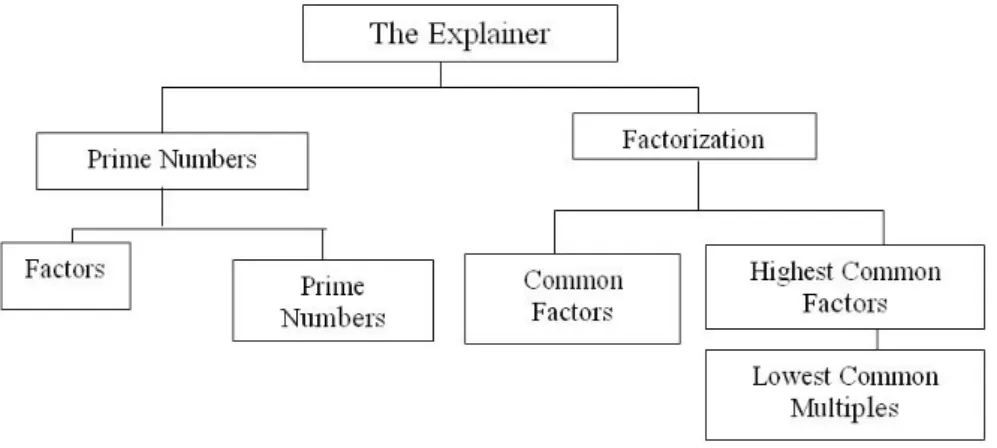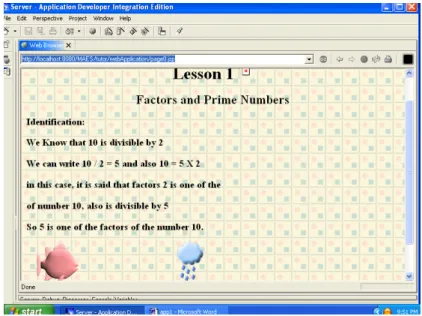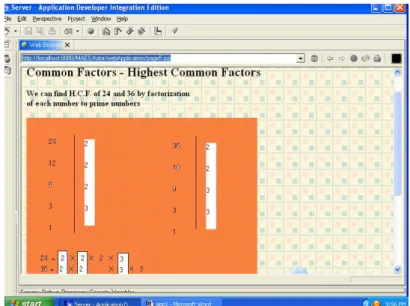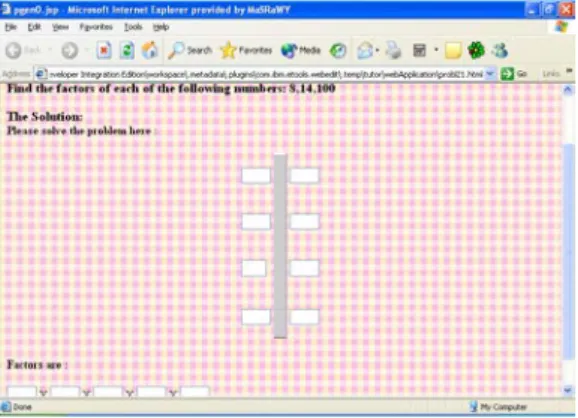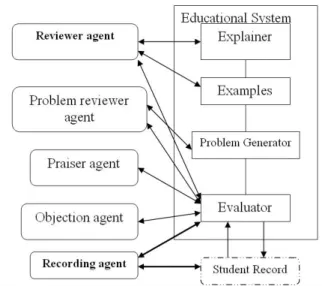Mona Hafez Mahmoud – Ayman El-Dosouky – Salwa Hamada
Electronic Research InstituteHala H. Zayed – R El-Kammar
Zagazige university, Shoubra Faculty of Engineering
A MULTI AGENT EDUCATIONAL SYSTEM
Abstract
The Intelligent Agent (IA) is currently an important field and hot research in the Artificial Intelligence field. IA, for education, is classroom -and platform- indepen- dent because such a system generally will be online, so it can be used by a huge number of learners [1].
In this paper, we are proposing a multi-agent system for an educational applica- tion. The system includes an educational system which is composed of an explainer module, a problem generator module and an evaluation module. There are a group of agents that help the system to do its job. The system has a graphical user interface and can be connected to the Internet. The student can go through the explainer, then to the problem generator, which shows a set of problems and gives a possibility for the student to solve this problem step by step; then the answers go through the eva- luation module, which analyzes them, and identifies the problem areas which are difficult for the student, and shows how we can treat these problems. Also, it stores the scores of the student in a student record and shows it to him/her, in a self exp- lanatory form if he/she requests it.
During all of these procedures a system of five intelligent agents helps to get our objectives from this system.
1. Introduction
Agent technology is considered as the next generation of design and manufactu- ring systems. Researchers have already applied agent technology in designing many systems in many fields. The intelligent agent is a natural system that senses its environment and takes actions according to its objectives [2],[3].
A non-intelligent agent is a group of operations that can be executed to represent an action or reaction. Intelligent agents sometimes have one goal, and sometimes have more, but they must have more knowledge agents as regards reasoning in the space of their activity.
Also, they contain more knowledge about the needs, preferences and patterns of behavior of the person or process and it may also know about other intelligent
agents. So, the basic differences between non intelligent agents and intelligent agents are behavior and environment [4], [5].
When using intelligent agents technology in education, an intelligent tutor can determine the student’s level of knowledge on the subject, define weakness in his/her skills, form lessons and exercises to educate the student, correct misconcep- tions and strengthens a student’s skills. Here, intelligent agents are used as delegates for the human when this task costs too much if it is performed by human and the agents are capable of high quality performance and human; trust [7], [8], [9].
2. Intelligent and non-Intelligent agents
A non-intelligent agent is an executable operation composed of simple sta- tements of action or reaction.
An intelligent agent contains more knowledge about the needs, preferences and patterns of behavior of the person or process that spawns the intelligent agent, and it may also know about other int. agents and resources that might exist in the network.
Thus, the basic distinction between simple agents and intelligent agents are in behavior and environment [2], [10], [11], [12].
3. Multi agents system (MAS)
Agents in a multi agent system (MAS) necessarily interact with other agents.
They may compete for a resource or collaborate toward the solution of a problem or toward the achievement of a common goal. For example, when an agent has to wait to access a resource because other agents are using it, the agents main tool for inter- action is communication. Communication allows agents to exchange information as well as requests for services. For example, an agent that needs to make financial decisions may want to ask other agents for stocks quotes, or it may want to subcont- ract parts of its financial analysis out to other agents. When combining communica- tion and problem solving, the solution to a problem is rarely restricted to the agent itself; rather, it often involves other agents [8], [9], [10], [14], [15], [16].
Intelligent agents have a dual behavior: they are goal-directed programs that au- tonomously and proactively solve problems for their users; on the other hand, agents have a social dimension too, when they are participating as a part of a multi-agent system (MAS) [11], [12], [13], [14], [15], [19]. There are problems interest in kno- wing how to allocate agents to computers and launching them onto remote hosts.
Once the agents have been launched, the question ishow to monitor their run-time status so as to manage computing resources effectively [14], [20], [21]. As autono- mous problem solvers, agents need to develop a model of their environment that allows them to reason on how the actions they perform affect their environment, and how those changes lead them to achieve their objectives. Ontologies provide the conceptual framework that allow the given agents to construct such models. Onto- logies describe the type of entities that agents encounter, the properties of those entities, and the relations between them. For example, a stock-reporting agent may require ontologies describing not only concepts like the ticker symbol, but also the
relation between stock and ticker symbol and the properties of stocks (such its value expressed in some currency) [17], [21].
4. Agent system architecture
Agent system architectures give the organizing frameworks within which agents are designed, while an infrastructure provides the services that are available to the agents as they operate.
Here, we classify the agent-based system architectures into three categories: hie- rarchal architectures, federated architectures and autonomous agent system architectures [2].
4.1. Hierarchal architectures
A traditional hierarchal architecture organization is shown in Figure 1. The hig- hest level is a manufacturing enterprise, which implemented as a central node, consists of various databases and knowledge bases, with monitoring, reasoning, decision making and control mechanisms. Subsystem managers are subordinate to this central node. Each subsystem manager controls a group of resource agents. Each resource agent may be a manufacturing device, a human being, a CAD/CAM tool, or other software or hardware [2].
Figure 1: A general hierarchal architecture for agent based design and manufactu- ring system
Manufacturing Enterprise
Shop floor manager1 Shop floor
manager1 Department
Manager 1
4.2. Federated architecture
In hierarchal architecture there is a serious problem that is associated with the central node. Federated multi-agent architecture is considered a good solution for an industrial agent-based application
There are several widely accepted approaches, such as:
– The facilitator approach – The broker approach – The matchmaker approach – The mediator approach [2]
4.3. Autonomous architecture:
This type of architecture should have the following characteristics:
1. It has knowledge about other agents and its environment.
2. It is not controlled or managed by any other agents or humans.
3. It has its own goals and an associated set of motivations.
4. It can communicate and interact with other agents in the system or extra/other systems.
This architecture does not provide a shared knowledge, yet there is a dependence [2].
Figure 2: Autonomous Agent system Architecture
5. Domain Knowledge of the system
The Domain Knowledge contains two „lessons”: “the prime numbers and number factorization” which are a part the grade four math class in elementary schools, shown in Figure 3. We chose this domain for two reasons:
– The students in this stage are facing difficulties in these lessons specifically.
– Such lessons are more difficult in language schools.
In the first lesson we take “Factors” and “Prime numbers” and in the second les- son we take “Common factors” and the “ Highest and Lowest common factors” [22].
Figure 3: Domain Knowledge
6. The used Tool in the system
In this system we used “Websphere Application Developer Integration Editi- on”(WSAD). This tool works with the Java Server Page (JSP) technology. A JSP is a text based document that describes how to process a request to create a response.
JSP technology supports a number of different paradigms for authoring dynamic content. The key features of Java Server pages are:
– Standard directives – Standard actions – Scripting element – Tag extension mechanism – Template content
Such a tool gives the facility to use the commands of HTML, the commands of JAVA and the Java script. So it gives a huge number of commands you can use in the programs. In addition to this, there is a simulation of a server in the package and you can run the programs on it instead of using the Internet each time [23], [24], [25], [26], [27].
7. The Multi Agent Educational System (MAES) architecture:
The internal architecture of the system is shown in Figure 4, which shows us that the system consists of:
– An Educational system, which consists of:
− An Explainer module.
− A problem solving module.
− An evaluator module.
− Student record.
– A group of Intelligent Agents.
– Communication Interface.
– Infrastructure network or Internet.
7.1. The Educational system:
The educational system has the most important role in the system. It explains the domain then generates a group of problems, receives the student’s answers to analy- ze them, diagnoses the student’s problems then treats them. Also, it records the stu- dent’s status via his answers in the student record.
Figure 4: The internal structure of the system
7.1.1. The working session of the Explainer Module:
The Explainer module passes through two phases to do its job. This job is to exp- lain the lesson, via a:
– Text screen explaining phase.
– Generating examples phase.
7.1.1.1. Text Screen explaining phase:
This phase takes the identifications that each part of each lesson include and displays them on a graphical form screen. Some examples of these screens are in Figure 5.
Figure 5: one of the text screens for the first lesson (factors)
7.1.1.2. Generating example phase
This phase gives examples for each part of each lesson and shows them on in a graphical form screen, taking into account the fact that the student is interacting in solving the example. Here, demonstration of an example for every part of each les- son is represented
For part I of lesson 1 (factors)
= 2 X 6
2 is one of 6 is one of the factors of 12 the factors of 12 then 12= 3 X --- appears
here I give the student a chance to write a number instead of the points and the system takes the number he put and compares it with “4”; and if the two numbers are matched the system shows that:
12 = 3 X 4
3 is one of 4 is one of the factors of 12 the factors of 12
If his answer doesn’t match the right one the system will declare a message that says “try again, your answer is wrong” and the system shows 12 = 3 X ---- again and
gives him another chance, takes his answer again, then compares it with the right one; if it is the right answer the system proceeds again, and if it is wrong the system tells the student to check the multiplication table.
The system continues in the same way until the system has got all the factors of
“12”; it then deals in the same way with other examples [22].
Figure 6: An example from the first lesson (factors)
For part II of lesson 1 (prime numbers):
After explaining what prime numbers are and how we get them, the system shows gives examples, like:
Write down the prime numbers between 1 and 20.
Solution:
2, 3, 5, 7, 11, 13, 17, 19
The system then shows some examples with incomplete solutions, and gives the student a chance to complete this solution -and then sees if it is right or wrong.
For part I of lesson 2 (number factorization):
30 =----X 6 30 = 2 X 5 X ----
30 = 3 X --- 30 = 1 X ---
All of these are called “factorization” for the number 30.
A factorizing for the number 30, using graphics and animation, are then created in the front of the student, like:
30 2
15 3
5 5
1 therefore 30 = 2 X 3 X 5
The system subsequently shows some other examples using graphics and ani- mations as depicted in Figure 7.
Figure 7: An example of the second lesson (prime factors)
For part II of lesson 2 (Common factors – highest common factor H.C.F.):
The system gives an example, using graphics and animation, to obtain common factors of 24 and 36:
24 2 36 2
12 2 18 2
6 2 9 3
3 3 3 3
1 1
24 = 2 X 2 X 2 X 3 36 = 2 X 2 X X 3 X 3 H.C.F. =2 X 2 X 3= 12
Figure 8: An example of the second lesson (highest common factors)
Via the same strategy, the system uses some examples to show persons how to get the lowest common factor, like:
Multiples of the number 6 are 0,12,18,24,30,36,--- Multiples of the number 9 are 0,9,18,27,36,--- The common multiples of both 6 and 9 are 0,18,36,----
The smallest multiple of these common multiples, except 0, is called L.C.F.
Also the system shows to the student that he can get L. C. F. by using factori- zation [22].
7.1.2. A working session of the Problem Solving module:
The job of this module is abbreviated in three tasks:
– To represent a group of problems for every lesson.
– To represent a group of lower level problems given a student’s wrong answers.
– To provide a special screen for every type of problem the studentdeals with. [28]
It comes with a graphic background and sound.
Here are some examples of the problem screens as they appear when we run the module, in which we can see the graphic user interface:
Figure (9-a): A form of a problem from the first lesson
Figure (9-b): The form of another problem from the first lesson
Figure (9-c): The form of another problem from the second lesson
7.1.3. A working session for the Evaluation module:
This module is the heart of the system. Here, the answers of the student are eva- luated. The system takes the answers of the student step by step and checks if they are correct or not; it then diagnoses the problem of the student and records everything in the “student record”, as shown in the example of Figure 10.
The problem in Figure 6 is taken as an example to show how the evaluator mo- dule works. This problem has three problems inside, because the task is to get the factors of 8, 14, 100; this problem appears with its answering screen, and the student will answer on this and then press the button “submit” to send these answers to the Evaluator. The Evaluator module will work like this:
Figure 10: Another problem for the second lesson
If the student answers correctly for the number (8) the next number will appear (14) on the same screen, giving a student the chance to solve this then (100) comes if he answers correctly. His evaluation will be recorded in his “student record”.
– If he answers wrong the first time, the system will consider that it is a mistake in writing the numbers, so it gives him another chance to solve the same problem.
– If he answers wrong the second time, the system will diagnose the problem of the student (e.g. that he may not understand the examples very well) so the system will show him a lower level problem of the same type on the same answering screen. The same strategy will be repeated. If he then answers wrong- ly or correctly, this will finally be recorded in his “student record”.
– If he answers wrongly the next time, the system will know that he did not un- derstand all of the lesson -so the system takes him to the Explainer to check the lesson another time, and then shows him the problem again [28].
7.1.4. The Student Record
This is a file in which everything about the student’s answers will be recorded i.e.:
– If she/he answers correctly or not, ont he first attempt, or subsequently.
– Diagnosing the student’s problem and seeeing how to treat it.
– Scores and evaluation for the student, such as: Excellent, very good, and so on.
[28]
7.2. The intelligent agents:
The agent system architecture is autonomous (as talked about previously).
Thus, MAES agents are autonomous cognitive entities with communication ca- pabilities.
The system includes five intelligent agents, as shown in Figure 11:
1. Reviewer agent 2. Problem reviewer agent 3. Praiser agent
4. Objection agent 5. Recording agent
Figure 11: The educational system and its agents
7.2.1. The Internal structure of an agent
Each agent consists of five parts (as shown in Figure 12):
1. Symbolic model of the agent
2. Internal K.B. of the module that the agent is dealing with.
3. Local knowledge of the model of the task to be performed 4. The communication interface
5. The network interface
Figure 12: Internal structure of an agent
7.2.2. Reviewer agent:
The Reviewer agent deals with the explainer module, example module and eva- luator module. When the system checks a student’s answer and finds that it is wrong, and gives him a chances to correct himself, though he can’t, the system will take him to the examples or the explainer pages again to get more understanding of the lesson. That is the job of this agent.
7.2.3. Problem reviewer agent:
When the system checks the student’s answer and finds that it is wrong the first time, it gives him another chance to solve the same problem, so the system needs to re-show the problem and its solving screen. Also, if it is the second time and the student answers wrongly, the system displays a lower level problem for the student to solve. So this agent is helping him/her to do these tasks. Thus, this agent is hand- ling the problem generator module and evaluator module.
7.2.4. Praiser agent:
Its job is to praise the student when he/she answers the problem correctly. A praising message appears, with beautiful music, as shown in Figure 13. So this agent needs to deal with the evaluator module.
Figure 13: Form of the praiser screens
7.2.5. Objection agent
This agent deals with the evaluator module. Its job is to make objections to the student when he answers incorrectly. A message appears that shows that his answer is wrong, with a sad music, as shown in Figure 14.
Figure 14: Form of the objection screen
7.2.6. Recording agent
This agent deals with the evaluation module and student record. The evaluation module evaluates the student answers and sends to the recording agent the informa- tion about the student and her/his answers -which records such information in a file with the name of the student. This file is called the student record. Then, when the student asks to see his scores the agent can open this file to show him.
8. Conclusions
Through this research an educational system is being implemented using intelli- gent agent technology. The educational system is composed of an explainer module, an example module, a problem solving module, an evaluation module and student record. The educational system is aided by a group of intelligent agents that help the system to behave intelligently with the students. After implementing the system, it will be on line. So, any student in any place can easily use it.
References
[1] Jiming Liu, Ning Zhong, “ Intelligent Agent Technology systems, Methodology, and tools”, World Scientific publishing Co. Pte. Ltd., 1999.
[2] Weiming Shen,Douglas H. Norrie and Jean-Paul A. Barthes, “Multi agent systems for concurrent intelligent design and manufacturing”, Taylor &
Francis Inc., 2001.
[3] Kthryn Heilmann, Dan Kihanya, Alastair Light, Paul Musembwa, “Intelligent agent: A technology and business application analysis”, Intelligencia Inc., November 30, 1995.
[4] James A. King, “Intelligent Agents: bringing goods things to life”, (AI expert), PP. 17–19, February 1995.
[5] James A. King, “Intelligent Agents: part2”, (AI expert), PP. 10–12. March 1995.
[6] Peter Brusilovsky, “Adaptive and Intelligent Technologies for web based Educa- tion”, Carnegie Mellon University, 2003.
[7] Yang Xiang, “Probabilistic Reasoning in Multi-agent systems: A graphical mo- dels approach”, Cambridge university press, 2002.
[8] Katia Sycara, Massimo Paolucci, “Ontologies in Agent Architecures”, Robotic Institute, Carnegie Mellon university, 2003.
[9] M. H. Mahmoud, A. Eldesouky, R. Elkammar, H. H. Zayed, S. Hamada, ”An Explainer of a multi agents educational system”, 11th International confe- rence on Artificial Intelligence Applications, 2003.
[10] Jim Kerstetter, “Intelligent agents infiltrate startup”, Pc week, volume 14 P8(I), 1997.
[11] Klusch, M. and Sycara, K., “Brokering and matchmaking for coordination of agent societies”, In Coordination of Internet Agents, A. Omicini et al.
(eds.), Springer., 2001
[12] Giampapa, J. A. Sycara, K., “Conversational case-based planning for agent team coordination”, In the Fourth International Conference on Case- Based Reasoning (ICCBR-2001), Vancouver, British Columbia, Canada, 2001.
[13] Joseph A. Giampapa, Octavio H., Katia P. sycara, “Configuration Management for Multi Agent Systems”, Robotic Institute, Carnegie Mellon university, 2003.
[14] Langley, B., Paolucci, M., and Sycara, K., ”Discovery of infrastructure in multi agent systems”, In Agents 2001 Workshop on Infrastructure for Agents, MAS, and Scalable MAS, 2001.
[15] Terry R. Payne, Massimo Paoluci, Rahul Singh, and Katia Sycara, “Communi- cating Agents in open Multi Agent Systems”, Robotic Institute, Carnegie Mellon university, 2003.
[16] Paolucci, M. and Sycara, K., “An exploration in MAS scalability”, IJCAI, 2001.
[17] Michael R. Genesereth and steven P.Ketchpel, “Software agents”, (communica- tion of the ACM),July 1994, vol. 37, no. 7.
[18] Margaret A.Boden, “Agents and creativity”, (communication of the ACM), vol.
37, no.7, July 1994.
[19] Charles J. Petrie, “Agent-based engineering on the web, and intelligence”, (IEEE expert), pp. 24–29, 1996.
[20] Sachiyo Arai, Katia Sycara and Terry R. Payne, ”Multi agent reinforcement learning for scheduling multiple-goals”, In Proceedings of the Fourth In- ternational Conference on Multi-Agent Systems (ICMAS’2000).
[21] Arai, S., and Sycara, K., “Effective learning approach for planning and scheduling in a multi-agent domain”, In Proceedings of the 6th Interna- tional Conference on Simulation of Adaptive Behavior , pp. 507–516, 2000.
[22] Herber Schidt, Joe O’Neil,”JAVA programmer’s reference”, 1997.
[23] William Buchanan,”Mastering JAVA”, McMillan, 2000.
[24] Jamie Jaworski, “Java 1.2 Unleashed”, (Sams),1998.
[25] Vivian Neou, “HTML 4.0 with JavaScript”, Prentice Hall, 2001.
[26] JGuru, “Java Server Pages fundamentals”,
http://developer.java.sun.com/developer/onlineTraining, 2000.
[27] JGuru, “Exception Handling in JSP”,
http://developer.java.sun.com/developer/onlineTraining, 2000.
[28] M. H. Mahmoud, A. Eldesouky, R. Elkammar, H. H. Zayed, S. Hamada, ”The tutoring system of a multi-agents system”, 2nd joint international confe- rence on E-learning, Delta Academy of science, Mansoura, Egypt, 2003.


